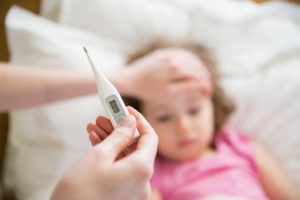If a child or infant experiences pain in the hip, radiating into the leg, this may be due to hip rhinitis. The harmless disease subsides on its own within one to two weeks without special therapy.
In most cases, the disease is triggered by a virus-related respiratory tract infection. Mild fever may occur under certain circumstances. Furthermore, a reduction in the sedimentation rate of the blood cells may be observed.
Table of contents
Hip Cold – What Is It Actually?
Hip rhinitis was first discovered and described in 1982. Robert Williamson Lovett and John Lovett Morse jointly found that a diagnosis of the condition was not possible until several days after the symptoms had subsided. In addition, they were able to distinguish the disease from hip joint tuberculosis based on symptom duration.
Transient Synovitis
In medicine, hip rhinitis is also known as transient synovitis. This is an inflammation of the hip joint without the presence of triggering germs. Most children and toddlers, as well as babies, have been affected.
In this context, it is striking that most patients are between four and seven years old. In addition, boys are affected significantly more often than girls. The inflammation disappears on its own within one to two weeks.
How Hip Rhinitis Is Triggered
In most cases, a virus-related infection of the respiratory tract is the cause of hip rhinitis. A mild fever may occur in this context. In addition, the sedimentation rate of blood cells may decrease. In detail, however, the causes of hip rhinitis have not yet been clarified.
However, it is assumed that the inflammation is due to an immune reaction of the body. This causality can be assumed based on the previous infection of the respiratory tract.
During this triggering infection, the ears (for example, otitis media), tonsils, intestines, and respiratory tract are usually affected. Medically unlikely, on the other hand, are connections with other clinical pictures, such as hip dysplasia, which is excluded, for example, during the U3 screening examination.
How To Recognize Hip Dysplasia
Like every clinical picture, hip rhinitis also has characteristic symptoms that indicate a disease. In most cases, these appear very quickly and unexpectedly.
The affected children limp, with unilateral pain in the groin, pain in the hip with radiation into the leg, or pain in the groin and thigh causing the limp. In principle, there is no possibility of hip rotation in the presence of a hip limp. Thus, the leg cannot be rotated at the hip.

Rarely Bilateral Pain
In very rare cases, the inflammation affects both sides. However, in most cases, the pain occurs only on one side of the hip. Mild fever or a slight increase in body temperature occurs in approximately one-third of sufferers. Proper measurement of fe ver is very important in this context.
Children Usually Find It Difficult To Tolerate Pain
Symptomatic pain in the groin or pain in the hip with radiation into the leg is very difficult to bear for most children. This is especially due to the fact that the complaints are associated with a significant restriction of movement.
In general, however, it should be mentioned that hip pain subsides on its own after a few days or weeks and does not require drug treatment. After the symptoms have subsided, the affected children suffer neither pain nor restricted movement.
Summary Of Symptoms
- Sudden, usually unilateral pain in the groin or pain at the hip.
- Restriction of leg movement.
- Lack of ability to rotate the hip.
- Severe pain from the thigh to the knee.
- Possibly slightly elevated temperature up to slight fever.
The Diagnosis Of Hip Pain
Doctors generally have two different ways to diagnose hip rhinitis with certainty. To begin, a medical history is usually taken. If the history confirms a suspicion of hip rhinitis, the practitioner usually resorts to sonography, which can be used to diagnose hip rhinitis with certainty.
Medical History Provides Information About Hip Rhinitis
During the anamnesis, the physician asks a variety of questions, the answers to which are potentially relevant to the diagnosis. On the basis of a detailed questioning, hip rhinitis can often already be diagnosed.
In the context of hip rhinitis, the parents or guardians are usually questioned. If the children are already somewhat older, it may also be possible to interview the children themselves.
Sonography To Confirm Hip Rhinitis
An initial suspected diagnosis based on the medical history can be confirmed or ruled out by sonography. This is a special ultrasound examination.
The affected and painful areas are examined in detail. Existing inflammations that trigger the pain in the groin or the pain in the hip with radiation into the leg are visible during sonography.
X-rays Are Not Necessary For Hip Pain
X-rays of the hip are not necessary in the context of hip rhinitis. Only for possible differential diagnosis is X-ray examination advised. If x-rays are ordered, they are done at most after sonography, to confirm the diagnosis.
Medical Observation Necessary In Case Of Hip Rhinitis
In principle, it is necessary to medically observe the young patients with hip rhinitis, so that regular visits to the doctor are required. The reason for this is that hip diseases, which include hip rhinitis, can have various late consequences.
In addition, hip rhinitis has a significant similarity to other diseases, such as femoral head dislocation in adolescents, osteoarthritis of the hip joint, or Perthes’ disease, which is a pediatric orthopedic disease. To rule out bacterial infections of the hip, the treating physician may perform a puncture.
Effectively Treat The Hip Rhinitis
Usually, no medical intervention is required to treat hip rhinitis. Provided the pediatrician diagnoses the condition, sparing is strongly advised.
Depending on the severity of the pain in the groin and the pain in the hip with radiation into the leg, a low-dose painkiller may be useful. Anti-inflammatory drugs may also be prescribed if necessary.
However, causative therapy is not necessary. After one to two weeks at the most, the hip rhinitis and its symptoms will subside on their own. However, if it is a bacterial inflammation of the hip, surgical treatment is absolutely necessary.
Tips For Hip Rhinitis
1. If your child suffers from hip rhinitis, it is advisable to relieve the hip. Your child should take care of the hip joint as well as the knee and the affected leg. Movement should be kept to a minimum. Generally, bed rest can go a long way toward sparing.
2. You can help your child get through the duration of the disease more calmly with anti-inflammatory and pain-relieving medications. In addition, the symptoms of the disease are significantly reduced by the medications mentioned.
Relapse Is Very Rare
So far, relapse has been described in only one fifth of patients. In most cases, relapse occurs due to a poor healing process or treatment that is too short.
In general, therapy should always be given for as long as the pediatrician prescribes. If the pain in the groin or pain in the hip with radiation into the leg subsides before then, medical advice is still required.
FAQs About Hip Pain
Where Does The Pain Of Hip Rhinitis Occur?
Hip rhinitis causes pain in the groin, pain in the hip with radiation into the leg, and general pain in the hip and pain in the groin and thigh.
What treatment is suitable for hip rhinitis?
In principle, no special treatment is required for a hip rhinitis. What is important is sufficient rest for the hip and the affected leg. Painkillers and anti-inflammatory drugs may be useful.
How Long Should My Child Take It Easy With Hip Rhinitis?
The duration of rest is prescribed by the pediatrician. Regular visits to the pediatrician are essential for hip rhinitis. In general, it can be assumed that the necessary sparing is required for a maximum of two weeks.
Which Doctor Should Be Consulted For Hip Rhinitis?
The contact person for hip rhinitis is always the pediatrician. He or she can carry out and supervise the entire treatment.
Can Adults Also Get Hip Rhinitis?
Adults can also get hip rhinitis. In most cases, however, the disease occurs between the ages of four and seven.
Is Hip Rhinitis Contagious?
Hip rhinitis is not a contagious disease.
Can Children With Hip Rhinitis Go To School Or Daycare?
Generally, children with a hip rhinitis can attend the respective community institution. There is no risk of infection. However, early attendance at school or daycare has a negative effect on the healing process.
During the illness, the hip and the affected leg should be spared as permanently as possible.










